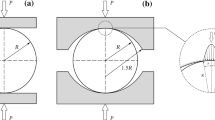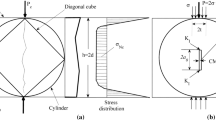Abstract
Splitting strength determined in the Brazilian test is assumed to be a property independent of size and uniquely related to the intrinsic material strength. However, as was experimentally demonstrated by various authors, the splitting strength depends on the specimen size. In this paper, the size effect in the Brazilian test is analyzed theoretically using a nonlinear fracture model based on cohesive crack concepts and the results obtained are compared with the classical strength limit approach. Two important variables are studied: the load-bearing strip and the geometry of the specimen. From the numerical results a closed form expression is proposed, dependent on the width of the bearing strip and on geometry. The results confirm that splitting strength decreases with the specimen size, tending towards an asymptotic solution for large size specimens. Within the size range analyzed (0.1 m to 2.5 m diameter for typical concrete) the splitting strength can vary by up to 25% in cylindrical specimens and by up to 35% in prismatic square section specimens, although this size effect is strongly dependent on the load-bearing strip. For widths of bearing strip smaller than 4% of the specimen diameter, the effect of the specimen size is negligible and the splitting strength approaches the tensile strength for any practical specimen size.
Résumé
La résistance mécanique en traction indirecte déterminé à partir de l'essai brésilien est censée être une propriété indépendante de la taille des éprouvettes et devrait dépende seulement de la rśsistance mécanique intrinsèque du matériau. Cependant, comme l'ont montré expérimentalement plusieurs auteurs, la résistance mécanique dépend de la taille des éprouvettes.
Dans cet article, une analyse théorique de l'effet de taille dans l'essai de compression diamétrale, a été développée en employant un modèle de rupture non-linéaire basé sur les concepts de la théorie de la fissure cohésive. Les résultats obtenus ont été confronté à ceux qui proviennent de l'approche de la théorie de la contrainte limite. Deux variables importantes ont été étudiées: la forme des appuis et la géométrie des éprouvettes.
Une expression analytique fermée dépendante de la largeur des appuis et de la géométrie a été trouvée. Les résultats confirment que la résistance mécanique décroît avec la taille des éprouvettes, tendant toujours vers une solution asymptotique pour des éprouvettes de grande taille. Dans le domaine des tailles analysées (0,1 à 2,5 m de diamètre pour un béton conrant), la résistance peut varier jusqu'à 25% dans des éprouvettes cylindriques et jusqu'à 35% dans le cas des éprouvettes prismatiques de section carrée, bien que cet effet soit aussi très dépendant de la largeur des appuis. Pour des largeurs d'appuis inférieures à 4%, du diamètre, l'effet de taille devient négligeable et le résultat s'approche de la résistance mécanique pour toutes dimensions d'éprouvettes.
Similar content being viewed by others
References
Mihashi, M., Okamura, H. and Bazant, Z. P., ‘Size effect in concrete structures’, E&FN Spon, London, 1993.
Petersson, P. E., ‘Crack growth and development of fracture zone in plain concrete and similar materials’, Report TVBM-1006, Division of Building Materials, Lund Institute of Technology, Sweden, 1981.
Alexander, M. G., (1987) in ‘Fracture mechanics for failure of concrete’, Shah, S. P. and Ouyang, C.,Annu. Rev. Mater. Sci. 24 (1994) 293–320.
Elices, M., Guinea, G. V. and Planas, J., ‘Prediction of size effect based on cohesive crack models’, in ‘Proc. IUTAM Symp. on Size Scale Effect in the Failure Mechanisms of Materials and Structures’, Torino, Italy, (October 1994) 3–7.
Planas, J., Guinea, G. V. and Elices, M., ‘Rupture modulus and fracture properties of concrete’, in ‘Fracture Mechanics of Concrete Structures’, (Ed Folker H. Wittmann), Proceedings FRAMCOS-2, Zurich, Switzerland, July 1995, 95–110.
Sabnis, G. M. and Mirza S. M., ‘Size effects in model concretes?’,Journal of Structural Division, ASCE 105 (ST6) (1979) 1007–1020.
Hasegawa, T., Shicya, T. and Okada, T., ‘Size effect on splitting tensile strength of concrete’, in Proceedings Japan Concrete Institute 7th Conference, jun 1985, 309–312.
Kim, J. and Eo, S., ‘Size effect in concrete specimens with dissimilar initial cracks’,Magazine of Concrete Research 42 (1990) 233–238.
Bazant, Z. P., Kazemi, M. T., Hasegawa, T. and Mazars, J., ‘Size effect in Brazilian split-cylinder test: measurements and fracture analysis’,ACI Materials Journal 88 (3) (1991) 325–322.
Rocco, C., Guinea, G. V., Planas, J. and Elices, M., ‘The effect of the boundary conditions on the cylinder splitting strength’, in ‘Fracture Mechanics of Concrete Structures’ (Ed Folker H. Wittmann), Proceedings FRAMCOS-2, Zurich, Switzerland, July 1995, 75–84.
Chen, W. and Yuan, R. L., ‘Tensile strength of concrete: the double punch tests’,Journal of the Structural Division ASCE 106 (ST8) (1980) 1673–1693.
Hondros, G., ‘Evaluation of Poisson's ratio and the modulus of materials of low tensile resistence by the Brazilian (indirect tensile) test with particular references to concrete’,Australian Journal of Applied Science 10 (3) (1959) 243–268.
Lundborg, N., ‘Strength-size relation of granite’,International Journal of the Rocke Mechanics and Mining Sciences 4 (1967) 269–272.
Timoshenko, S. P. and Goodier, J. N., ‘Theory of elasticity’, Mc Graw-Hill, New York, 1951.
Nilson, S., ‘The tensile strength of concrete determined by splitting tests on cubes’,RILEM Bulletin 11 (1961) 63–67
Tang, T., ‘Effects of load-distributed width on split tension of unnotched and notched cylindrical specimenes’,Journal of Testing and Evaluation 22 (5) (1994) 401–409.
Hillerborg, A., Modéer, M. and Petersson, P. E., ‘Analysis of crack formation and crack growth in concrete by means of fracture mechanics and finite elements’,Cement and Concrete Research 6 (1976) 773–782.
Elices, M. and Planas, J., in ‘Fracture Mechanics of Concrete Structures’ Elfgren, L., Ed., Chapman & Hall, London, 1989, 16–66.
Elices, M., Planas, J. and Guinea, G. V., in ‘Fracture and Damage of Concrete and Rock’, Rossmanith, H. P., Ed., E&FN Spon, London, 1993, 3–33.
Wittmann, F. H., Roelfstra, P. E., and Kamp, C. L., ‘Drying of concrete: an application of the 3L-approach’,Nuclear Engineering Desing 105 (1988) 185–198
CEB 90, ‘Model code for concrete’, CEB-FIP, 1990.
Rocco, C., Guinea, G. V., Planas, J. and Elices, M., ‘Mechanisms of rupture in the splitting test.’,ACI Materials Journal 96 (1) (1999) 52–60
Planas, J. and Elices, M., ‘Asymptotic analysis of a cohesive crack: 1. Theoretical background’,International Journal of Fracture 55 (1992) 153–177.
ACI 318, ‘Building code requirements for reinforced conrete’, American Concrete Institute ACI 318-77.
Author information
Authors and Affiliations
Additional information
Both participate in the work of RILEM Technical Committee QFS (Size effect and scaling of quasibrittle fracture). Prof. Elices also participates in RILEM TC 147-FMB (Fracture mechanics applications to anchorage and bond) and 148-SSC (Test methods for the strain softening response of concrete). Prof. G. Guinea is the 1994 Robert l'Hermite medallist. The first part of this paper (experimental analysis) has been published in Materials no 217.
Rights and permissions
About this article
Cite this article
Rocco, C., Guinea, G.V., Planas, J. et al. Size effect and boundary conditions in the brazilian test: theoretical analysis. Mat. Struct. 32, 437–444 (1999). https://doi.org/10.1007/BF02482715
Received:
Accepted:
Issue Date:
DOI: https://doi.org/10.1007/BF02482715




